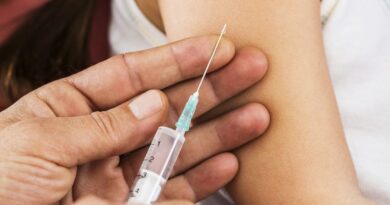What RFK Jr. Gets Wrong About Autism
Robert F. Kennedy Jr. makes a variety of incorrect or misleading claims about vaccines, COVID-19 and other health-related topics, as we discuss in other articles in this series. But his views on vaccines rose to prominence when he began to advance the thoroughly debunked idea that they cause autism — and he is repeating his claims about autism as a presidential candidate.

The prevalence of children identified as having autism has risen in recent decades, but changes in awareness of the neurodevelopmental disorder and how it is defined play a major role in this increase, as we have written before. There may be some true increase in autism, but there’s no evidence that vaccines are a cause.
Early on, anti-vaccine groups and individuals falsely connected vaccination for measles, mumps and rubella to autism. But substantial research has disproven this idea, and a 1998 Lancet paper purporting to show a link has been retracted.
Kennedy, who’s running for the Democratic nomination for president, wrote a story co-published in 2005 by Rolling Stone and Salon in which he incorrectly claimed that the preservative thimerosal — used to prevent contamination of vaccine vials — was linked to the “epidemic of childhood neurological disorders.” Salon later retracted the story, citing concerns about its accuracy and value. It is also no longer available on the Rolling Stone website.
In fact, multiple studies have found no evidence exposure to thimerosal causes autism or other neurodevelopmental conditions. Thimerosal is no longer used in vaccines given to children, with the exception of some flu shots, and yet autism diagnoses have continued to rise.
“No there is absolutely no evidence that vaccines cause autism,” Catherine Lord, a clinical psychologist and autism researcher at the David Geffen School of Medicine at UCLA, told us in an email. “This proposition has been repeatedly rejected including withdrawal of the first article that proposed it (and subsequent loss of medical status of its author) and every study since then,” she said, referring to the retracted Lancet paper.
David Mandell, a psychiatric epidemiologist, health services researcher and director of the Center for Mental Health at the University of Pennsylvania, told us, “Every single rigorous study we have” shows “no association” between autism and vaccination.
In recent interviews, Kennedy’s autism-related talking points have coalesced around a few misleading or untrue statements about the rise in autism diagnoses and vaccines, which we will discuss below. We reached out to his campaign with a list of questions about his claims, but we haven’t received a response.
Autistic People Exist in All Generations, Despite What Kennedy Implies
Researchers generally agree that increasing awareness of autism, expansions in its definition and the growing availability of services all have contributed to an increase in diagnosed cases in younger generations. While there may be some true increase in autism, the rise, if any, is less dramatic than it appears.
“It is possible that the actual incidence of autism has increased somewhat over the last 20 or 50 years, but we do know that much of that increase is not real,” Lord said.
To bolster claims of an “autism epidemic,” Kennedy has repeatedly made misleading statements about the nonexistence of older autistic people while using an incomplete description of autistic people in general. Kennedy is an attorney and not a scientist or medical professional.

In a June 5 SiriusXM town hall, Kennedy, who is 69 years old, told radio and TV host Michael Smerconish: “I have never in my life seen a man my age with full-blown autism, not once. Where are these men? One out of every 22 men who are walking around the mall with helmets on, who are non-toilet-trained, nonverbal, stimming, toe-walking, hand-flapping. I’ve never seen it.”
He said on a June 15 episode of the “Joe Rogan Experience” podcast: “I bet that you’ve never met anybody with full-blown autism your age. You know, head banging, football or helmet on, non-toilet-trained, nonverbal. I mean, I’ve never met anybody like that my age.”
Researchers criticized Kennedy’s characterization of autism. Lord and Mandell told us there’s no such diagnosis as “full-blown autism,” the behaviors of autistic people and support they need vary, and there are autistic people in Kennedy’s generation.
“Many of them would not have been recognized as such but they absolutely do exist,” Lord said.
The Diagnostic and Statistical Manual of Mental Disorders – which Mandell called the “psychiatry bible” — since 2013 has defined autism spectrum disorder as including symptoms from two different categories: deficits in social communication and interaction, as well as restricted and repetitive behaviors. These symptoms manifest differently in different people.
Due to the wide range of characteristics and needs of autistic people, some researchers have proposed a new category called profound autism, Mandell said. This diagnosis would be given to autistic people who will require the constant presence of an adult to help them throughout their lifetime. These people usually have an intellectual or language disability, or both.
Mandell said that perhaps Kennedy was in fact referring to people with profound autism. But even if so, “his statement that there’s no one his age who has profound autism or you haven’t met them — you may not have met them, but that’s very different from them not existing. And what he has said is patently false.”
According to the most recent Centers for Disease Control and Prevention prevalence data, 1 in 36 children born in 2012 has an identified autism diagnosis. There is no system set up to monitor autism prevalence in adults, according to CDC researchers. However, in 2017 agency scientists estimated an autism prevalence of 1 in 45 in adults using modeling based on data from children, taking into account the shorter life expectancy for autistic people. Such individuals have a heightened risk of dying from suicide, accidents and diseases of the nervous system such as epilepsy, as well as other health conditions.
There are multiple reasons older adults with autism may not be visible to someone like Kennedy. Older adults with a lower need for support might have learned to hide their symptoms, either aware or unaware of their diagnosis. Older adults with profound autism might have a different diagnosis and might have spent much of their lives in mental institutions, where people with developmental or psychiatric disabilities commonly were sent in earlier generations.
In a 2011 study of people living in a state psychiatric hospital in Pennsylvania, for instance, Mandell and his colleagues found that 10% of those evaluated met criteria for autism. None of these people had current autism diagnoses, and many had instead been diagnosed with schizophrenia.
Part of the increase in autism diagnoses in younger generations comes from a broader and more flexible list of symptoms that define autism. “The definition of autism has changed back and forth since it was first described by Leo Kanner and Hans Asperger in 1943 and 1944, and those changes and how we define it have a lot to do with who we say has autism and how many people we say have autism,” Mandell said.
It took until 1980 for autism to be established as its own DSM diagnosis. The definition of autism broadened in the 1980s and 1990s, leading to a greater proportion of children meeting the definition. There’s also evidence people have been increasingly diagnosed with autism when they previously would have received a different diagnosis.
“We know that some of the rise in autism diagnoses is due to a broadening of the concept of autism, some of it is due to greater awareness of both the general population and providers of autism, and some of it is due to diagnostic substitution,” Lord said.
The newer definitions allowed more flexibility in which criteria people needed to meet to get a diagnosis. To receive an autism diagnosis under the 1980 DSM criteria, for instance, a person needed to show all of the following characteristics: “pervasive lack of responsiveness to other people,” “gross deficits in language development” including “peculiar speech patterns” in those who could speak, and “bizarre responses to various aspects of the environment.”
By 1987, someone would need to just show eight out of 16 possible characteristics, allowing for a broader range of autism manifestations. For instance, someone with good verbal ability could still get an autism diagnosis if showing an impairment in nonverbal communication or imaginative activities, along with meeting some combination of other criteria.
Kennedy told Smerconish at the SiriusXM town hall: “If the autism epidemic was an artifact … of new changing diagnostic criteria or better recognition, you would see it in all age groups.” But medical and governmental recommendations and policies encouraged diagnosis in younger generations without providing similar pathways or incentives for those who were already adults to get diagnosed.
In 1990, the Individuals with Disabilities Education Act established autism as a named disability for which appropriate services must be provided by public school educators. In 2006, the American Academy of Pediatrics recommended routine autism screening for toddlers. And in the 2000s and 2010s, all 50 states mandated that some insurance plans cover behavioral therapies for autistic children.
Further, a diagnostic requirement is that the person had symptoms in early life, but adults may not have access to information on their early characteristics.
Kennedy Recycles False Claim Linking Autism to Vaccines
There are some known factors that have likely led to a slight true increase in the number of autistic people. These include a rise in infants with birth complications who survive and in children born to older parents — both factors implicated in autism.
It is also known that a person’s genetics can influence the likelihood of being diagnosed with autism. Other factors, such as prenatal exposure to air pollution or pesticides, and certain maternal health conditions, have also been associated with an increased risk of autism.
However, there’s no compelling sign that vaccines are associated with autism, nor does it make sense that a vaccine given to a child would cause autism. “We’re pretty sure if there’s an environmental toxin that causes autism it’s in utero,” Mandell said.
Still, scientists have studied childhood vaccines and autism extensively — looking into multiple suggested components and vaccine types — and found no connection.
To support his claims about vaccines and autism, Kennedy returns again and again — including in recent interviews with Rogan and Smerconish — to the same 20-year-old, two-phase study by CDC scientist Dr. Thomas Verstraeten and colleagues. The researchers used the vaccine safety monitoring system Vaccine Safety Datalink to screen for a connection between thimerosal and various health outcomes. In the end, they found “no consistent significant associations” between thimerosal-containing vaccines and autism or other neurodevelopmental conditions.
Thimerosal in vaccines is broken down in the body to form ethylmercury. This mercury-containing compound is distinct from methylmercury, which is known to cause neurological problems in humans.
Verstraeten and colleagues’ study came about after various government and professional groups in 1999 recommended that thimerosal be phased out of vaccines as soon as possible. This was a precautionary measure resulting from uncertainty at the time about the impacts of ethylmercury. The preservative was eliminated from childhood vaccines in 2001, even though there was no evidence that it had harmed children.
Flu vaccines, which contain thimerosal when packaged in multidose vials, were subsequently routinely recommended for children for the first time. Given the increasing evidence for “lack of any harm resulting from exposure to such vaccines,” the CDC’s Advisory Committee on Immunization Practices endorsed the vaccines regardless of whether they contained thimerosal.
Kennedy and others have misleadingly portrayed Verstraeten’s work as showing a connection between vaccines and autism. Verstraeten said in a 2004 letter published in Pediatrics that neither phase of his study provided a final answer on whether there was a connection between neurodevelopmental disorders and vaccines. (We reached out to him for this article and did not receive a reply.) The ultimate conclusion of the project was that more research was needed. As we’ve previously mentioned, data from multiple other studies refute the idea that thimerosal and neurodevelopmental disorders are linked.
Kennedy and others have said that Verstraeten originally uncovered a link between autism and thimerosal in vaccines and that his finding was subsequently diluted. In the 2004 letter, Verstraeten denied his findings were watered down. Versions of this rumor have been resurrected repeatedly and repeatedly debunked.
The first phase of the study was discussed at a CDC meeting that Kennedy has misleadingly portrayed as a cover-up attempt. The data presented at the meeting did not in fact show a significant association between thimerosal exposure and autism, but rather a few other associations between thimerosal and neurodevelopmental disorders in specific contexts.
The conclusion of Verstraeten and colleagues, according to meeting materials, was that they could not “rule out” a relationship between thimerosal and neurodevelopmental disorders based on their early analysis — not that they had established a connection. Next, the researchers did their planned second analysis, looking at data from another group of children. This second phase of the study did not show a significant link between thimerosal-containing vaccines and autism or other neurodevelopmental conditions.
Recently, Kennedy has been highlighting a statistic of dubious origins that he claims is derived from an even earlier version of Verstraeten’s work. He told Rogan, for instance, “What he [Verstraeten] found in his first run through the data is there was an 1,135% greater or elevated risk for an autism diagnosis among the kids who had gotten it [the hepatitis B vaccine] in their first 30 days. At that point, they knew what caused the autism epidemic.” Kennedy also refers to these children as having a relative risk for autism of 11.35, which converts to a 1,035% increased risk.
There’s no record of Verstraeten publicly presenting a relative risk of 11.35. Instead, the number appears in a 2004 presentation from SafeMinds, an autism-focused anti-vaccine group that helped bring thimerosal concerns to prominence in the first place.
SafeMinds says in the presentation that it obtained statistical tables from Verstraeten’s early analyses via a Freedom of Information Act request. The group claims the data showed a relative risk of autism of 7.62 to 11.35 in children with the highest exposures to thimerosal versus those who weren’t exposed in their first month of life. The presentation does not include the actual documents the group says it obtained via the FOIA request, and the presentation does not include details like confidence intervals. (We reached out to SafeMinds about getting the original documents but did not get a reply.)
It is unclear on what Kennedy bases his assertion that a relative risk of 11.35 corresponds to risk from the hepatitis B vaccine. SafeMinds suggests that achieving the highest category of thimerosal in a child’s first month “required an unusual pattern of exposure,” consisting, for instance, of a hepatitis B vaccine plus another vaccine given early.
Even if Verstraeten did come up with a relative risk of 11.35 at some point — a fact that is not established — it would have been incorrect to conclude based on such a preliminary analysis that vaccines were behind “the autism epidemic.” And of course, much more rigorous studies have since been performed, rendering any of these early findings entirely moot.
In fact, Verstraeten wrote in 2004: “Continuing the debate of the validity of the screening study is a waste of scientific energy and not to the benefit of the safety of US children or of all children worldwide that have the privilege of being vaccinated.”
Kennedy Misleads About Timing of Rise in Autism and Vaccines
Another piece of Kennedy’s argument about vaccines and autism relates to timing. As we have discussed, the number of children with autism diagnoses has increased in the past several decades, although any true increase is likely small. There are also a variety of beneficial childhood vaccines that have become available in the last few decades and have been added to the CDC’s recommended vaccine schedule.

Of course, many things have increased in recent decades, and not all of them are related. “People like Kennedy can pick their favorite two trends that happen to be going in the same direction and point to them as causal,” Mandell said.
But when researchers have looked at how well trends in autism line up with vaccine introductions and changes, it contradicts the hypothesis that they are connected. For instance, one study found similar autism case trends in Sweden, Denmark and the U.S. from the mid-1980s through the late-1990s, even though thimerosal was removed from vaccines in Sweden and Denmark in the early 1990s.
Kennedy tries to argue for a more exact correspondence in the timing of an autism “epidemic” and a boom in childhood vaccines, focusing on the year 1989. He told Rogan that an Environmental Protection Agency study “said 1989 is the year the epidemic began. It’s a red line. And 1989 was the year the vaccine schedule exploded. That doesn’t mean that’s a correlation. It does not mean causation, but it is something that should be looked at.”
But it’s not possible to pinpoint the beginning of the increase in autism cases to 1989, Mandell said, given the sparseness of data on how many people had autism at that time.
Lord told us that “there is nothing special about 1989 in the frequency of autism. The increase has been relatively steady beginning in the 1970s and partly has to do with when there were prevalence studies in the U.S., U.K., and Canada.”
Kennedy appears to base his statement on a 2010 study by two EPA researchers, who suggested 1989 as one possible turning point for autism diagnoses. But this was not consistent across datasets they looked at. Other studies find slightly different turning points, or give a range of years when the increase began.
One vaccine was added to the vaccine schedule in 1989, for Haemophilus influenzae type b. This was followed by the hepatitis B vaccine in 1994, the chickenpox vaccine in 1996, various versions of the rotavirus vaccine beginning in 1998 and more vaccines since then. These vaccines have prevented serious diseases and deaths and, as we have said, have not had an impact on the rate of autism.
Kennedy often says he is simply urging that research be done, such as when he told Rogan that the connection between autism and vaccines “is something that should be looked at.” But these statements alone are misleading, implying that there has not been research into the topic at hand. As we have discussed, researchers have applied significant scrutiny to vaccines and autism and failed to find a relationship between them.
Researchers told us that the very act of making these claims about autism harms people.
Mandell argued there are harms to calling for more research into already disproven associations. “With the same funds and the same energy that are going to these specious speculations about correlations, we could be putting that into solving the housing crisis for autistic adults,” he said.
“Having autism is complicated enough for individuals and their families without someone using them for political purposes,” Lord said. “Also discouraging families from vaccinating children against preventable diseases (that have nothing to do with autism) causes families to take risks with their children’s health for no reason.”
Editor’s note: SciCheck’s articles providing accurate health information and correcting health misinformation are made possible by a grant from the Robert Wood Johnson Foundation. The foundation has no control over FactCheck.org’s editorial decisions, and the views expressed in our articles do not necessarily reflect the views of the foundation.



